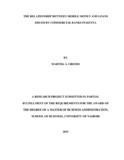| dc.description.abstract | Lending which may be on short, medium or long-term basis is one of the main services
that commercial banks do render to their customers. According to Adedoyin and Sobodun
(1991), lending is undoubtedly the heart of banking business. Therefore, its
administration requires considerable skill and dexterity on the part of the bank
management. Commercial banks in Kenya are fast embracing the mobile technology as a
platform to operate on and increase not only their presence, but also their efficiency and
general profitability. Mobile money has transformed the way people in the developing
world transfer money and now it is poised to offer more sophisticated banking services
which could make a real difference to commercial banks‟ lending performance. The
study sought to determine the relationship between mobile money and loans issued to
customers by commercial banks in Kenya.
This research adopted a descriptive research design. The population of this study was all
the 43 commercial banks in Kenya as at September 2015 where a census survey was
adopted. Secondary data on mobile money, especially the value of transactions, was
collected from the Central Bank of Kenya‟s Bank Supervision reports as well as from the
online repositories. Further, data on customer deposits and loans was collected from the
Bank Supervision reports. The data on number of mobile banking users was obtained
from the Communication Authority of Kenya‟s annual reports. All the data was collected
on annual basis from 2007 to 2014 since mobile banking was introduced in Kenya in
2007.
The study revealed that the value of transactions had a positive but insignificant effect on
loans and advances, p > .05. The results also showed a negative relationship between
number of users and loans but the relationship was insignificant, p > .05. Further, the
results showed that deposits had a positive effect on loans. The relationship was
marginally significant at 5% level but significant at 10% level. Since both measures of
mobile money were insignificant, the study concludes that mobile money does not
influence the loans issued by commercial banks in Kenya. The study recommends that to
improve on the loans and advances, banks should come up with more mobile based loan
products for the customers. Secondly, the study recommends that loan products based on
the mobile money platform should extend beyond the cash advanced to bank clients. In
order to achieve more mobile money penetration, the study recommends that more banks
should partner with the telecommunication firms by allowing them to operate mobile
money loan services without the customers having to open accounts with the banks at
their branches. | en_US |

